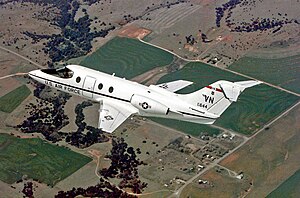Raytheon T-1 Jayhawk
| T-1 Jayhawk / T-400 | |
|---|---|
 | |
| General information | |
| Type | Trainer aircraft |
| Manufacturer | Raytheon Hawker Beechcraft |
| Status | Active service |
| Primary users | United States Air Force |
| Number built | 180 |
| History | |
| Manufactured | 1992–1997 |
| Introduction date | 17 January 1992 |
| First flight | 5 July 1991[1] |
| Developed from | Beechjet/Hawker 400A |
TheRaytheon T-1 Jayhawkis a twin-engined jet aircraft used by theUnited States Air Forcefor advanced pilot training. T-1A students go on to fly airlift and tanker aircraft. TheT-400is a similar version for theJapan Air Self-Defense Force.
Design and development
[edit]The T-1A Jayhawk is a medium-range, twin-engine jet trainer used in the advanced phase of Air ForceJoint Specialized Undergraduate Pilot Trainingfor students selected to fly strategic/tactical airlift or tanker aircraft. It is used also for training Air ForceCombat Systems Officersin high and low level flight procedures during the advanced phase of training. It also augmented or served in lieu of theT-39 Sabrelinerin the Intermediate phase ofUS Navy/Marine CorpsStudentNaval Flight Officertraining until the joint Air Force-Navy/Marine Corps training pipeline split in 2010 and now remains solely in operation with the U.S. Air Force, leaving the Navy with the Sabreliner pending its eventual replacement. The T-1 Jayhawk shares the same letter and number as the long retiredT-1 SeaStarunder the1962 United States Tri-Service aircraft designation system.
The swept-wing T-1A is a military version of theBeechjet/Hawker 400A.It has cockpit seating for an instructor and two students and is powered by twin turbofan engines capable of an operating speed of Mach.78. The T-1A differs from its commercial counterpart with structural enhancements that provide for a large number of landings per flight hour, increasedbird strikeresistance and an additional fuselage fuel tank. A total of 180 T-1 trainers were delivered between 1992 and 1997.
The first T-1A was delivered toReese Air Force Base,Texas, in January 1992, and student training began in 1993.
Another military variant is theJapan Air Self-Defense ForceT-400 (400T) trainer, which shares the sametype certificateas the T-1A.[2]
Variants
[edit]
- T-1A
- United States military designation for trainer powered by two JT15D-5B turbofans, 180 built.[3]
- T-400
- Japanese military designation for theModel 400Tpowered by two JT15D-5F turbofans, also known by the project name TX; 13 built.[citation needed]
Operators
[edit]
- United States Air Force
- 12th Flying Training Wing–Randolph Air Force Base,Texas
- 14th Flying Training Wing–Columbus Air Force Base,Mississippi
- 47th Flying Training Wing–Laughlin Air Force Base,Texas
- 71st Flying Training Wing–Vance Air Force Base,Oklahoma
- 340th Flying Training Group–Randolph Air Force Base,Texas
- 5th Flying Training Squadron– Vance Air Force Base
- 43d Flying Training Squadron– Columbus Air Force Base
- 96th Flying Training Squadron– Laughlin Air Force Base
- 39th Flying Training Squadron– Randolph Air Force Base
Specifications (T-1A)
[edit]
Data fromJane's All The World's Aircraft 1993–94[4]
General characteristics
- Crew:3 (pilot, co-pilot/instructor, observer)
- Capacity:4 passengers
- Length:48 ft 5 in (14.76 m)
- Wingspan:43 ft 6 in (13.26 m)
- Height:13 ft 11 in (4.24 m)
- Wing area:241.4 sq ft (22.43 m2)
- Aspect ratio:7.5:1
- Airfoil:Mitsubishi MAC510
- Empty weight:10,450 lb (4,740 kg)
- Max takeoff weight:16,100 lb (7,303 kg)
- Powerplant:2 ×Pratt & Whitney Canada JT15D-5Bturbofan,2,900 lbf (13 kN) thrust each
Performance
- Maximum speed:468 kn (539 mph, 867 km/h) at 27,000 ft (8,200 m)
- Cruise speed:392 kn (451 mph, 726 km/h) long range cruise at 41,000 ft (12,000 m)
- Stall speed:93 kn (107 mph, 172 km/h)CAS
- Range:2,900 nmi (3,300 mi, 5,400 km)[5]
- Service ceiling:41,000 ft (12,000 m)
See also
[edit]Related development
Aircraft of comparable role, configuration, and era
Related lists
References
[edit]- ^William Green, Claudio Müller:Flugzeuge der Welt, 1992/93.Werner Classen Verlag, Zürich 1992,ISBN3 7172 0368 1,p. 38.
- ^"TC Data Sheet A16SW".
- ^Jackson 2003,p. 537.
- ^Lambert 1993,pp. 432–433.
- ^"T-1A Jayhawk".U.S. Air Force.Retrieved29 September2015.
This article contains information that originally came from a US Government website, in the public domain.USAF Website
Bibliography
[edit]- Jackson, Paul, ed. (2003).Jane's All the World's Aircraft 2003–2004.Coulsdon, UK: Jane's Information Group.ISBN0-7106-2537-5.
- Lambert, Mark, ed. (1993).Jane's All The World's Aircraft 1993–94.Coulsdon, UK: Jane's Data Division.ISBN0-7106-1066-1.
Further reading
[edit]- Wetzel, Gary (March 2011). "Jayhawk...training for the big stuff".Air International.Vol. 80, no. 3. pp. 64–69.ISSN0306-5634.
External links
[edit]- "Opinion: U.S. Air Force Overspending On T-1A, Its Forgotten Trainer".Aviation Week & Space Technology.3 March 2017.
